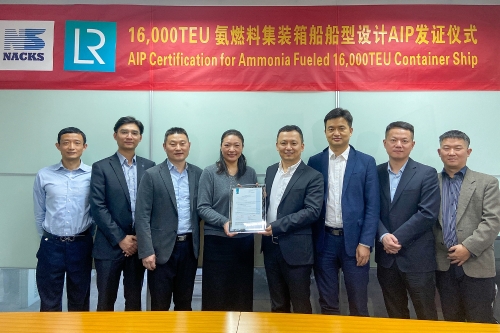| NACKS was awarded AIP Certificate by Lloyd's Register of Shipping for its research and development of ammonia fuel powered ships | |||||
| |||||
On October 11, Lloyd's Register of Shipping (LR) issued the Approval in Principle (AIP) certificate to the preliminary design of our 16000TEU ammonia fuel powered container ship. This project is a milestone for the application of ammonia fuel in container ships and shipping fields. Focusing on the flammability, high toxicity and corrosiveness of ammonia fuel, the technical team of the company conducted in-depth research on the layout and material selection of ammonia fuel tank, positioning of ventilation masts, ventilation detection of double-wall pipes, ammonia fuel filling technology, and detection and protection of ammonia leakage. At the same time, risk assessment meetings were held to fully discuss potential risks, providing solutions for future application in real ship projects. In close cooperation with Lloyd's Register of Shipping and Hudong Heavy Machinery, the initial design of the ship was completed, and the ship was finally awarded the Approval in Principle (AIP) certificate by LR. In recent years, liquid ammonia has been regarded by the industry as one of the most promising alternative fuels for achieving the goal of zero carbon shipping. Our company has always been committed to the research and development of clean energy ships. With different degrees of exploration around various low-carbon and zero carbon fuels, the company has successively completed the development of multiple LNG dual fuel ships and has invested a lot of research and development efforts in new fuel ships such as new biofuels, methanol fuel and ammonia fuel. In August this year, the company completed the research, development and design of the 300,000-ton (VLCC) dual-fuel carrier, which was recognized by Japanese Mitsui O.S.K. Lines (MOL) and successfully signed the order for two carriers. The research and development of ammonia fuel ULCS, which was approved in principle by LR, is another major breakthrough in promoting the development strategy of clean energy ships and provides another optional technology direction for the shipping industry to achieve the goal of greenhouse gas emission reduction. | |||||
